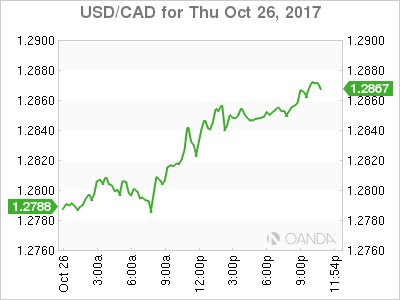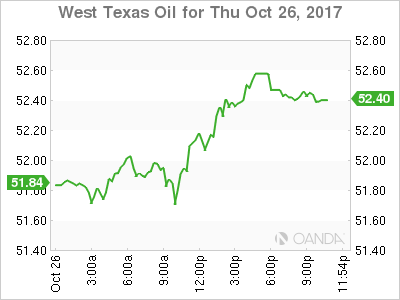The Canadian dollar fell against the US dollar on Thursday. There was no economic data on the Canadian calendar, with the market mostly focused on the European Central Bank (ECB) rate statement. The central bank delivered a compromised taper as expected. The ECB will halve the existing bond purchases down to 30 billion euros a month starting in January. The duration of the program was extended by 9 months to September 2018, although the door was open for extending even further if needed. The press conference with President Mario Draghi was even more dovish with the possibility of increasing bond buying if inflation conditions become less favourable and that there would be no sudden end to bond buying.
The lack of a hawkish ECB drove the USD higher as monetary policy divergence will continue to expand with the Fed expected to raise rates once again in December. The Bank of Canada (BoC) kept rates unchanged on Wednesday and also delivered a dovish statement which contrasted heavily with the hawkish comments that tipped the market about the July Canadian benchmark rate hike and the surprise September lift. After the October BoC meeting the probability of a rate hike in the remainder of 2017 are near 20 percent given the increasing headwinds and the unknown fate of the NAFTA agreement.
The Canada Mortgage and Housing Corp said today that the housing market boom is set to slow down in the next two years. Rising rates and a slowdown in the pace of growth of the economy will impact housing starts, with existing home sales to be affected as well. Prices will increase at a more moderate pace. The CMHC sees a 0.16 percent increase in 2018 and 2.4 percent in 2019.

The USD/CAD rose 0.41 percent on Thursday. The currency pair is trading at 1.2849 after the USD rose significantly on the back of a more dovish than expected ECB QE tapering announcement. The European Central Bank wanted to avoid a taper tantrum, and so far mission accomplished. European bond yields are lower after Mario Draghi did not set a specific timeline for the end of European QE. The US tax reform is closer to a reality with the house of representatives passing a budget resolution. US yields rose to 2.45 percent as Republicans are aiming to pass a tax bill before Thanksgiving.
The week will end with the release of the first estimate of the US gross domestic product (GDP) for the third quarter. Bureau of Economic Analysis will release the Advanced GDP at 8:30 am EDT with a forecast of 2.5 percent gain but a slowdown from the previous quarter at 3.1 percent. Much of the slowdown can be attributed to the negative effects of tropical storms that hit the US during the third quarter, but with overall temporary effects. Other US economic indicators have been positive despite the storm, so there is the possibility of the GDP performing better than expected on Friday.
There were no surprises from the Bank of Canada, which maintained the benchmark rate at 1.00 percent. In its rate statement, the Bank noted that wage growth levels remain weak, as there is slack in the labor market. Inflation pressure from wage growth remains muted, but the Bank did not provide a reason why inflation levels are so low. This problem is apparent south of the border as well, where a robust US economy and red-hot labor market has not translated into higher inflation. The cautious tone of the BoC did not impress investors, and the Canadian dollar shed close to 1.0 percent on Wednesday after the rate announcement.
Who will win the race to take over at the Federal Reserve? Janet Yellen’s 3-year term concludes in February 2018, and President Trump has said he will nominate a new Fed in the next few days. The front runners are economist John Taylor and Federal Reserve Governor Jerome Powell. Taylor advocates a rule in which rates which be as high as 3 percent, given current economic conditions. Powell is more closely aligned to Fed Chair Janet Yellen’s monetary stance which advocates an incremental increase in rates. With the two candidates representing sharply differing views on interest rate levels, Trump’s choice for the new Fed chair could have a significant effect on monetary policy and the strength of the US dollar. If Taylor gets the nod, the US dollar could respond with gains of 3 percent or more.

Oil prices rose on Thursday. West Texas Intermediate is trading at $52.40 finding some stability in the comments by Saudi Crown Prince Mohammed bin Salman who backed the extension of Organization of the Petroleum Exporting Countries (OPEC) production cut beyond its current March 2018 deadline. The group will meet in Vienna with Russia and other major producers on November 30 with the extension of the deal to be discussed.
Weekly crude inventories in the US rose 856,000, the first rise after four weeks when the forecast called for another big drawdown. Gasoline stocks dropped by 5.5 million barrels with a forecast that called for a mostly flat inventory statistic. Distillate stockpiles also had a massive drawdown of 5.2 million barrels. Heating oil demand drove the higher than expected demand.
Market events to watch this week:
Friday, October 27
8:30 am USD Advance GDP q/q













